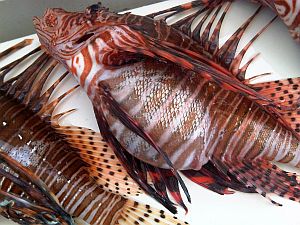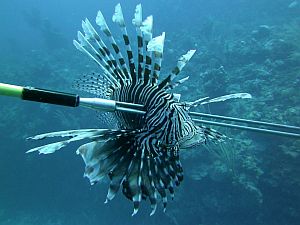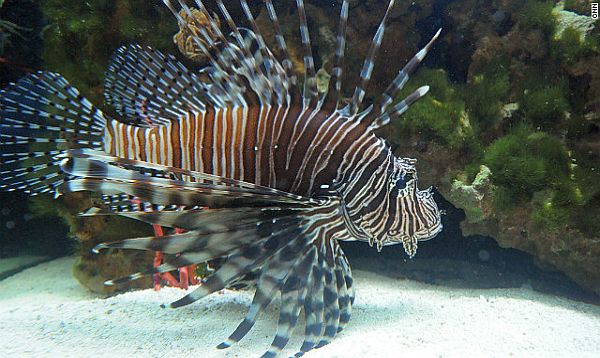The red lionfish sports maroon and white stripes to complement its venomous spines. A native of the Indian and Pacific Oceans, the red lionfish and its cousins have rapidly established a new domain from Cape Hatteras to the coast of Mexico and beyond.
The lionfish gorge on small fish, mollusks, and invertebrates, enough to fill out to over a pound in size and decimate local populations on the coral reefs they inhabit. Their arrival has caused quote "extreme disruption to native fish communities," according to the International Coral Reef Initiative, which is studying what to do about the lionfish invasion.
Conservationists wrestling with the problem of the invasive lionfish have suggested that recreationally and commercially harvesting the predatory species for food could put a big dent in its numbers.
 |
Lionfish arrived in the South Atlantic in 1985, most likely released by private aquarium owners, and have caused native fish populations there to decline by up to 80 percent. In the Bahamas between 2008 and 2010 they reduced biomass of 42 other fishes by an average of 65 percent.
By 2013, lionfish had spread throughout the Caribbean and Gulf of Mexico, reaching densities well above those in their native Indo-Pacific habitat and, unlike most invasive species, have shown no signs of slowing down. The invasion may be "one of the greatest threats of this century to warm temperate and tropical Atlantic reefs and associated habitats," wrote National Oceanic and Atmospheric Administration scientist James A. Morris, Jr., in Invasive Lionfish: A Guide to Control and Management.
Lionfish have enjoyed phenomenal success in their new range thanks to insatiable and far-from-picky appetites, impressive reproductive abilities, and lack of interest from native predators. Except, that is, for the planet’s top predator — Homo sapiens.
Derby Day
A number of presentations at the GCFI meeting reported that lionfish derbies or tournaments and regular, ongoing removal of the fish have reduced local Caribbean populations. "We’re finding throughout the region that local control is very successful at keeping numbers down," says Lad Akins of the nonprofit Reef Environmental Education Foundation (REEF.) "Divers and snorkelers are removing them and we’re actually seeing native fish communities coming back."
Green calls derbies one of the best control tools available. "Derbies engage people, train them to remove lionfish, encourage development of markets, and are effective for population suppression at a local scale," she says. "Tastings are a big part of it, too. We’ve surveyed participants and found that these events are changing attitudes toward eating lionfish."
Once derby participants learn how to safely collect and handle the venomous fish, organizers hope they will take lionfish at every opportunity. The Florida Fish and Wildlife Conservation Commission waives license requirements and bag limits for divers harvesting lionfish and Texas allows unlimited removal by spear, net, or hook and line in state waters. A number of Caribbean countries issue special permits allowing lionfish removal by otherwise illegal methods and in areas where fishing is normally prohibited. "Kill all you can" seems to be the universal message.
 |
Deadliest Catch
That level of reduction would require a major fishing effort with assistance from commercial fishers. Commercial operators are capable of harvesting from deeper waters as well, which harbor significant populations of larger lionfish with correspondingly sizeable appetites and reproductive capabilities.
Commercial fishery development shows much potential but also faces challenges. In Belize, where the sale of lionfish could conceivably help make up for dwindling lobster and conch catches, a hoped-for export market for the invasive species sputtered in the face of shipping costs. But some 20 fishers in Belize sell lionfish regularly to markets and restaurants, and more sell opportunistically or catch for personal use.
In Bermuda lobster fishers increasingly sell lionfish bycatch to restaurants and markets. Florida reported commercial lionfish landings in 2012 of over 11,000 pounds, Akins says, and unreported catch likely pushes the actual number higher. Lionfish is the number-two bycatch in Florida’s lobster fishery, and it fetches one of the highest prices per pound.
"Traditional Fisheries," a commercial supplier, brings lionfish to the US market from Cozumel and Puerto Morelos, Mexico. "The tiny island of Cozumel produced 12 tons of lionfish fillet in less than two years from maybe six square miles of sea," owner David Johnson says.
But regular, large-scale harvesting will depend on development of lionfish-specific techniques above and beyond spearfishing and bycatch. Johnson has developed a prototype, patented lionfish smart trap and is currently seeking funding to test and bring it to market.
In Bermuda the government, fishers, scientists, and nongovernmental organizations are collaborating on modifying lobster traps into a lionfish-specific model. Preliminary research indicates a high percentage of lionfish around Bermuda are in deeper waters. "One of the beauties of a trap is you can put it in 600 feet of water," Akins says. "But a lot of lionfish come up in traps that are full of other things, too, and that collateral damage is not worth using more traps. We need better ones."
Good Eating
 |
Lionfish meat also tastes good. "It’s a very white meat, mild and buttery, and lends itself to many different recipes," Akins observes. "So it has good taste and health benefits. It should also be a top choice for environmental reasons — it’s not just sustainable, but actually needs to be consumed." The Lionfish Cookbook, produced by REEF, includes collection and handling instructions and 20 recipes. Restaurants throughout the Caribbean and in Florida already serve lionfish.
Original Story


